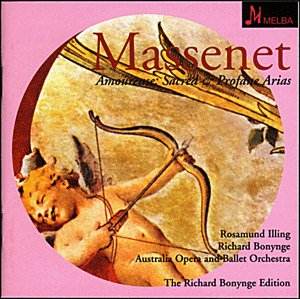 Composer: Jules Massenet (1842-1912)
Composer: Jules Massenet (1842-1912)
Works: Amoureuse: Sacred and Profane Arias
Performers: Rosamund Illing (soprano), Australian Opera and Ballet Orchestra, Richard Bonynge (conductor)
Recording: November 1998, Eugene Goossens Hall, ABC Sydney Australia
Label: Melba 301080
Duration: 74:43
Review Date: November 2001
Jules Massenet’s oeuvre, often relegated to the periphery of the late Romantic canon, illuminates the complexities of French operatic identity during a time dominated by the Italianate and Wagnerian paradigms. The recent release of Amoureuse: Sacred and Profane Arias, featuring the esteemed soprano Rosamund Illing, offers a curated selection from Massenet’s operatic and oratorial repertoire, showcasing both the lushness of his orchestral textures and the subtleties of his melodic contours.
The album contains a total of nineteen tracks, presenting arias from notable works such as Hérodiade, Le Cid, and Sappho. Massenet’s music is characterized by its rich orchestration and a fluid approach to melody, often described as drifting and dreamlike. This quality is particularly evident in arias like “Il est doux, il est bon” from Hérodiade, where the orchestral accompaniment swells with warmth, creating an atmospheric backdrop for Illing’s nuanced vocal delivery.
Illing’s performance is commendable; she navigates the intricacies of Massenet’s vocal lines with a delicate touch, harnessing both the lyrical and dramatic demands of the music. Her interpretation of “O mes soeurs” from Marie Magdeleine is particularly striking, where she employs a fervent expressiveness that captures the spiritual and emotional weight of the piece. However, one might argue that certain arias could benefit from more dynamic variation and character differentiation, which would enhance the overall dramatic arc of the compilation.
Historically, Massenet’s position in the musical landscape was precarious; he straddled the divide between the operatic innovations of the late 19th century and the nascent movements of the early 20th century. His work, while often overshadowed by contemporaries like Debussy and Ravel, offers a significant exploration of themes such as love, sacrifice, and the divine feminine. The critiques of his operatic compositions often hinge on their perceived lack of memorability; indeed, while the melodies may not linger in one’s mind as those of Puccini or Verdi, they encapsulate the essence of the French lyricism that Massenet so deftly championed.
In terms of performance context, Richard Bonynge’s conducting is vibrant and attentive, drawing out the orchestral colors with an understanding of Massenet’s stylistic nuances. The Australian Opera and Ballet Orchestra responds with clarity and depth, effectively capturing the lush harmonic language that is characteristic of Massenet’s score. The recording quality is pristine; the engineering by Melba ensures that each voice and instrument is rendered with clarity, allowing the listener to appreciate the intricate interplay between the soprano and orchestra.
When comparing this recording to other notable interpretations of Massenet’s works, one might reflect on the performances of Anna Netrebko or Natalie Dessay, who have also brought a contemporary sensibility to Massenet’s arias. Illing, however, carves her own niche with a more restrained and introspective approach, which may resonate differently with audiences familiar with the more flamboyant interpretive styles of her peers.
In conclusion, Amoureuse: Sacred and Profane Arias serves as both an homage to Massenet’s contributions to French operatic tradition and a showcase for Rosamund Illing’s vocal artistry. While the collection may not achieve the memorable heights of some operatic anthologies, it nonetheless invites listeners to engage with Massenet’s profound emotional landscapes and the intricate beauty of his musical language. This release is an important step in re-evaluating Massenet’s legacy, highlighting the need for continued exploration of his work within the broader tapestry of operatic history.